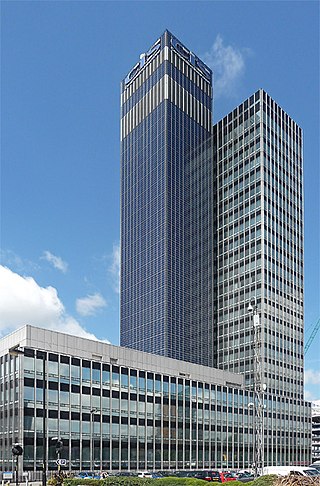
An architect is a person who plans, designs, and oversees the construction of buildings. To practice architecture means to provide services in connection with the design of buildings and the space within the site surrounding the buildings that have human occupancy or use as their principal purpose. Etymologically, the term architect derives from the Latin architectus, which derives from the Greek, i.e., chief builder.

Landscape architecture is the design of outdoor areas, landmarks, and structures to achieve environmental, social-behavioural, or aesthetic outcomes. It involves the systematic design and general engineering of various structures for construction and human use, investigation of existing social, ecological, and soil conditions and processes in the landscape, and the design of other interventions that will produce desired outcomes.

A cubicle is a partially enclosed office workspace that is separated from neighboring workspaces by partitions that are usually 5–6 feet (1.5–1.8 m) tall. Its purpose is to isolate office workers and managers from the sights and noises of an open workspace so that they may concentrate with fewer distractions. Cubicles are composed of modular elements such as walls, work surfaces, overhead bins, drawers, and shelving, which can be configured depending on the user's needs. Installation is generally performed by trained personnel, although some cubicles allow configuration changes to be performed by users without specific training.
Facility management or facilities management (FM) is a professional management discipline focused on the efficient and effective delivery of logistics and other support services related to real property and buildings. It encompasses multiple disciplines to ensure functionality, comfort, safety and efficiency of the built environment by integrating people, place, process and technology, as defined by the International Organization for Standardization (ISO). The profession is certified through Global Facility Management Association member organizations.
A virtual office is part of the flexible workspace industry that provides businesses with any combination of services, space and/or technology, without those businesses bearing the capital expenses of owning or leasing a traditional office.

The CIS Tower is a high-rise office building on Miller Street in Manchester, England. Designed for the Co-operative Insurance Society (CIS) by architects Gordon Tait and G. S. Hay, the building was completed in 1962 and rises to 118 m (387 ft) in height. As of February 2024, the Grade II listed building is Greater Manchester's 12th-tallest building and the tallest office building in the United Kingdom outside London. The tower remained as built for over 40 years, until maintenance issues on the service tower required an extensive renovation, which included covering its façade in photovoltaic panels.
Shearing layers is a concept coined by architect Frank Duffy, which was later elaborated by Stewart Brand in his book, How Buildings Learn: What Happens After They're Built, and refers to buildings as composed of several layers of change. The concept has been adopted by a number of technology vendors to also describe the different layers of systems within an organisation.
A serviced office is an office or office building that is fully equipped and managed by a facility management company, also known as an office provider, which then rents individual offices or floors to other companies. Serviced offices, also referred to as managed offices, flexible offices, business centers, executive suites or executive centers, are often found in the business districts of large cities around the world. A serviced office broker will commonly help business center owners and facility management companies to rent serviced office space. Companies offering serviced offices are generally able to offer more flexible rental terms, as opposed to a conventional leased office which may require furnishing, equipment, and more restrictive leases. Space is normally flexible, allowing for additional space to be allocated at short notice, should the size of an individual business change. Serviced office providers often allow tenants to share reception services, business machines and other resources, providing reduced costs and access to equipment which may otherwise be unaffordable. By providing businesses with access to a workplace, technology and people central to its operations, the serviced office can be considered a type of virtual office. Serviced offices are a central component to the flexible workspace industry.
A virtual workplace is a work environment where employees can perform their duties remotely, using technology such as laptops, smartphones, and video conferencing tools. A virtual workplace is not located in any one physical space. It is usually a network of several workplaces technologically connected without regard to geographic boundaries. Employees are thus able to interact in a collaborative working environment regardless of where they are located. A virtual workplace integrates hardware, people, and online processes.

Construction Industry Council (CIC) is the representative forum for professional bodies, research organisations and specialist business associations in the United Kingdom construction industry.

Ben van Berkel is a Dutch architect; founder and principal architect of the architectural practice UNStudio. With his studio he designed, among others, the Erasmus Bridge in Rotterdam, the Moebius House in the Netherlands, the Mercedes-Benz Museum in Stuttgart, Germany, Arnhem Central Station, the Singapore University of Architecture and Design, Raffles City in Hangzhou and numerous other buildings.

The MIT School of Architecture and Planning is one of the five schools of the Massachusetts Institute of Technology in Cambridge, Massachusetts. Founded in 1865 by William Robert Ware, the school offered the first architecture curriculum in the United States and was the first architecture program established within a university. MIT's Department of Architecture has consistently ranked among the top architecture/built environment schools in the world.
Convia, Inc., based in Buffalo Grove, Illinois, is an American manufacturer of components which provide an integrated energy management platform that allows for the control and metering of lighting, plug-loads and HVAC. It is notable as one of the first companies to deliver and control power while at the same time monitoring energy and adapting its use in real-time.
Workplace Strategy is the dynamic alignment of an organization's work patterns with the work environment to enable peak performance and reduce costs.
Corporate architecture refers to the use of architectural design to construct physical spaces that can promote the corporate image of a corporation. During the 20th century corporate architecture was able to transition from designs with mainly function in mind to more creative endeavours, which are able to be an architectural expression of the firm’s institutional identity and play a role in stakeholders’ image of the organisation.

Office space planning is the process of organizing the workplace layout, furniture and office functions to work effectively together, while using space efficiently. Floor plans should consider the workgroup function, building codes and regulations, lighting, teaming requirements, inter-communication and storage, as well as zoning for employee workstations, task space needs, support rooms and reception areas to make the best use of available space. Optimising office spaces with effective space planning can aid circulation, productivity and improve workplace wellness, as well as the health and safety of occupants.

David Lloyd Jones AA DIP, RIBA, FRSA is a founding partner of Studio E LLP, an architectural practice established in London in 1994. He has been described as "a godfather of the sustainable architecture movement in the UK". Lloyd Jones has been heavily involved in both promoting 'green' design and demonstrating it in practice. He has been responsible for a series of seminal bioclimatic buildings, including the National Farmers Union and Avon Insurance Head Office at Stratford upon Avon; the Solar Office Doxford International near Sunderland; Beaufort Court Zero Emissions Building at Kings Langley; Grange Park Opera House and the current new campus for The British College in Kathmandu. His book, Architecture and the Environment, was published in 1998. He is a founding member and chair of the charity Climate Change All Change.
Activity-based working (ABW) is an organizational strategic framework that recognizes that people often perform a variety of activities in their day-to-day work, and therefore need a variety of work settings supported by the right technology and culture to carry out these activities effectively. Based on activity, individuals, teams, and the organization are empowered to achieve their full potential by developing a culture of connection, inspiration, accountability, and trust. On a personal level, ABW also enables each person to organize their work activities in a way that best suits what and with whom they are trying to accomplish, promoting productivity and engagement at work. Although not normally implemented as a cost-saving business strategy, it can produce efficiencies and cost savings through more effective collaboration and team work. Inspiring spaces that evolve from an activity-based approach are designed to create opportunities for a variety of workplace activities, ranging from intense focused work to collaboration, as well as areas for meetings, whether formal or impromptu.
William Leopold Pulgram was an Austrian-born American architect.

Technology readiness levels (TRLs) are a method for estimating the maturity of technologies during the acquisition phase of a program. TRLs enable consistent and uniform discussions of technical maturity across different types of technology. TRL is determined during a technology readiness assessment (TRA) that examines program concepts, technology requirements, and demonstrated technology capabilities. TRLs are based on a scale from 1 to 9 with 9 being the most mature technology.









